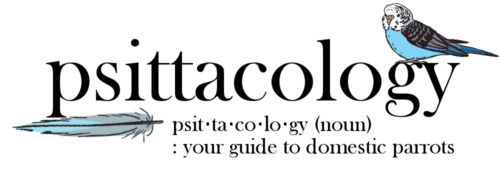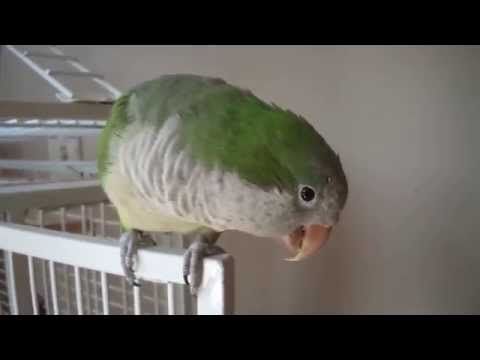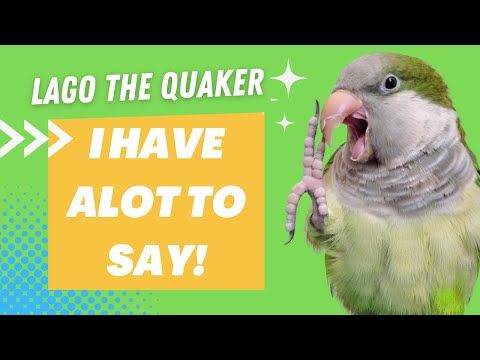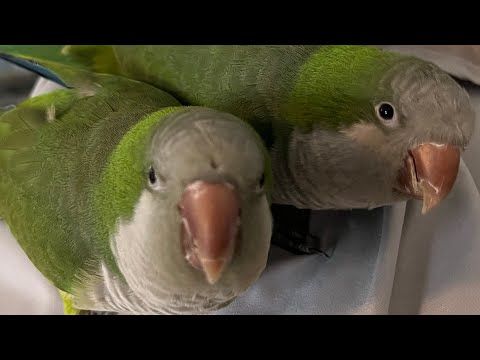The quaker parrot or monk parakeet (scientifically known as Myiopsitta monachus) is a fun-loving, spunky bird that is beloved as a domestic parrot. If you’re thinking about adding one to your family, you may be wondering: can quaker parrots talk?
Read on to find out everything you need to know about how well these beautiful birds can talk and how to teach them specific words and tunes.
This post contains affiliate links. If you make a purchase, a small percentage will go directly to Psittacology at no additional cost to you. Thank you for supporting Psittacology!
So, can quaker parrots talk?
The short answer to this question is: yes! Quaker parrots have the capacity to learn to imitate human speech, tunes and whistles.
Although they’re not at the absolute top of talking parrots – that honor definitely goes to birds like African greys and Indian ringnecks – quakers can still be pretty darn good at it. Their voice is quite squeaky and not always very clear, but they can learn to remember a large vocabulary of sounds, words, and phrases.
Aside from talking, a quaker parrot will spend much of the day chattering. They do scream and shriek as well, especially in the early morning and around sunset. Quaker parrots are considered loud: between their natural call and mimicking of human voices or sounds around the house, your home will be filled with noise all day long.
Remember that you should never buy a parrot just because of its potential talking ability. There is a lot more to owning one of these birds, and they’re considered high-maintenance pets.
You need to have a lot of time to spare, be able to handle a lot of noise and have the patience for careful training and socialization. On top of that, there is no guarantee your particular quaker parrot will actually learn how to talk! Still, it’s a fun bonus if it does.
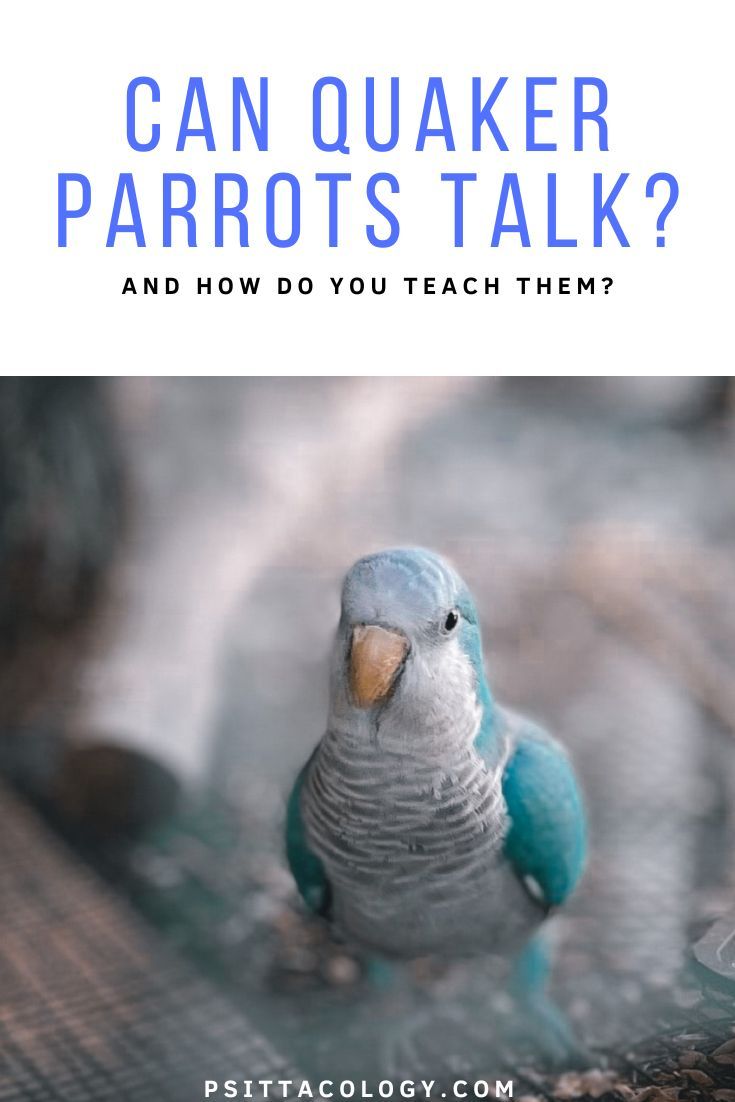
How to teach a quaker parrot to talk
So you’ve got a quaker parrot and want to know how to unlock its innate talent for talking? Although it can take a long time to see (or rather, hear) results, parrot talking training is easy, fun and a great way to bond with your bird.
The key ingredients to teaching your quaker parrot to talk are practice and a lot of patience. True, these smart birds will usually pick up on what you’re trying to teach them rather quickly, but there’s no guarantee.
You can follow the tips below to teach your bird how to talk. Remember: make sure your parrot is healthy and comfortable with your presence before beginning any type of training. If it’s not, it might be a good idea to have a look at how to tame a parrot first!
Did you know? A big part of the reason why parrots actually imitate sounds is to help them fit in with their flock. Only in this case, the flock is human! You can find out more in the post on why parrots talk.
Pick a word or phrase
When picking a word, phrase, or song to teach your quaker parrot, the most important things to keep in mind are shortness and simplicity. You don’t want to choose a phrase that is too long or a melody that is too complicated; this will just confuse your bird.
Try going for something short, like a high-pitched word or sound. This will be the easiest for your quaker to remember and repeat back to you. “Kiss-kiss”, “birdie”, “peekaboo” and the like tend to work pretty well.
Whistling is easier for birds than talking is. If you choose to teach your bird a song, it’s best to keep it to a single line. Try the tunes from “Tequila”, “Jingle Bells” or whatever short and sweet melody you prefer!
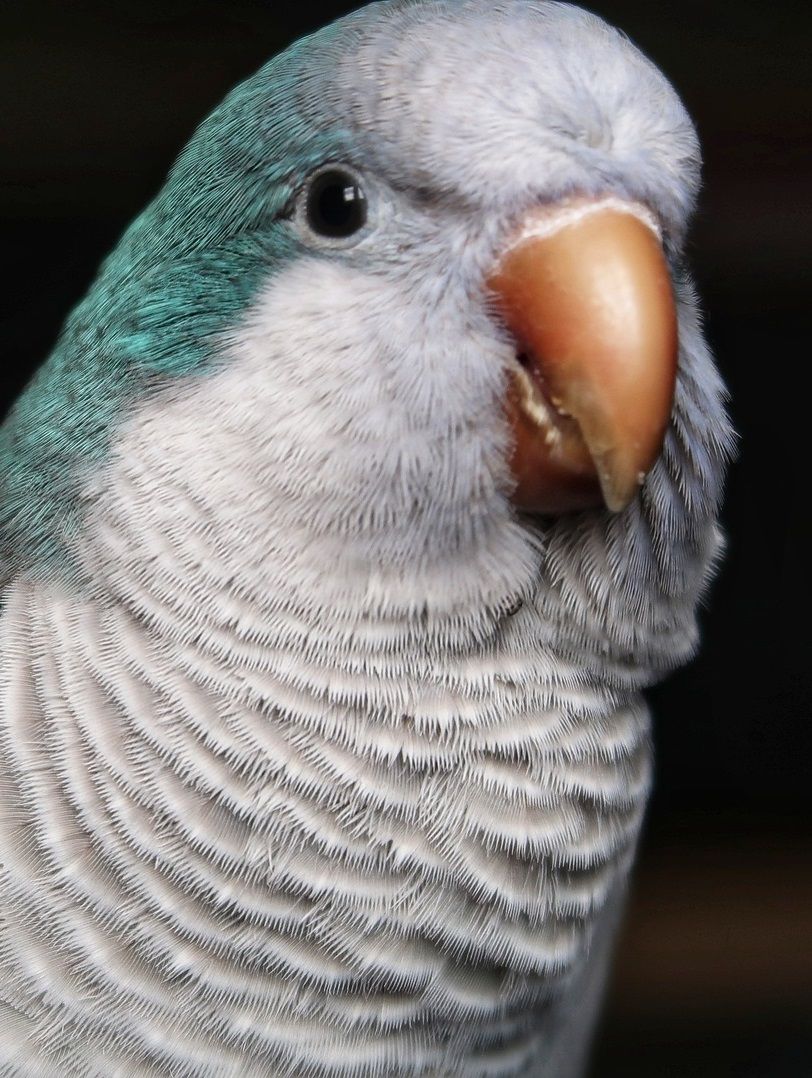
Repetition & positive reinforcement
Once you have chosen a word, phrase, or song to teach your quaker parrot, it’s time to begin training them to mimic your voice. The secrets? Patience and repetition.
The easiest way to do this is by consistently repeating the phrase when you’re near them. You can also take your bird into a quiet room for short, 5-minute repetition sessions multiple times a day. It’s best to repeat the target word or phrase in a high-pitched voice, as this is the easiest tone for parrots to mimic.
If you don’t have a particular phrase in mind, or simply want your parrot to have a more varied vocabulary, try speaking to them throughout the day. They’ll pick up on words they like and will often start to repeat them back to you.
Use physical cues
You can help your quaker parrot to learn words more quickly by associating them with physical cues. This can include waving your hand while saying “Hello” or “Hi-hi,” or saying “Goodbye” every time you leave the room.
When your bird sees these physical cues in the future, it’ll be more likely to associate them with the verbal cue you are trying to teach.
Training tools
While recordings and YouTube videos can be handy training tools, larger parrot species like the quaker parrot learn best with human interaction. The fastest way to train them to talk is to speak to them face-to-face, as they’re keen social learners.
You can use positive reinforcement to help in the training process. This can include verbal praise, or an occasional treat. Just be sure not to reward them with a snack every time they do well, or else you’ll end up with a chubby parrot!
Examples of quaker parrots talking
Here are some adorable examples of quaker parrots talking:
Why is my quaker parrot not talking?
If you are having trouble training your quaker parrot to talk, follow these tips to help with the training process:
- Take time to bond with your bird outside of its cage. Talk to it, share food with it, and let it become comfortable being in your presence.
- Place the cage in a busy room in your house. This will allow your quaker to be at the center of everything going on, and be able to hear most of the conversations that go on.
- Don’t forget to talk to your parrot every time you pass by its cage.
- Speak clearly, loudly, and in an excited tone of voice during your training sessions.
- Clearly enunciate each syllable of the words you want your bird to repeat.
If none of these things work, your parrot may just not be a talker. This isn’t uncommon with older birds or those that haven’t really grown up with humans. It’s too bad, but luckily, quakers have much more to offer than just their mimicking skills.
Frequently asked questions
Some quakers start trying to imitate human speech very early, at less than two months of age. Usually, though, they need around 6 months to start talking.
Sure do! Unlike female budgies or cockatiels, female quakers are chatterboxes just like their male counterparts.
So, can quaker parrots talk? You betcha! They’re beautiful birds that can make wonderful pets and companions. And yes, they’re known to be pretty good talkers. Many can be taught words, phrases, and songs.
Now that you know how to teach your parrot how to talk, enjoy bonding with it during training sessions! Don’t forget to keep some tasty treats on hand.
